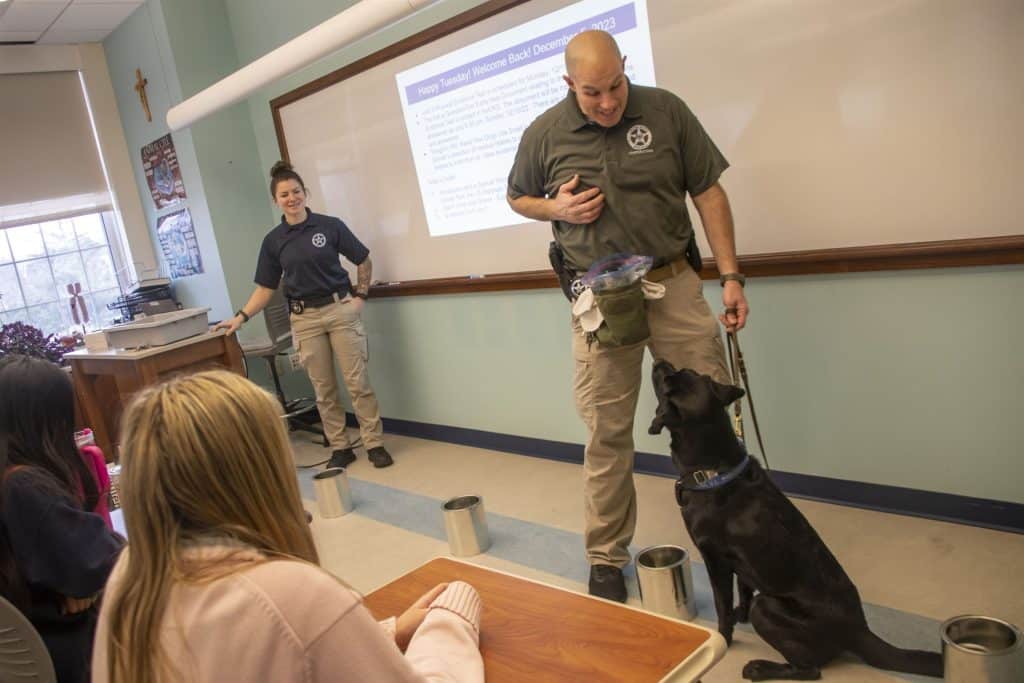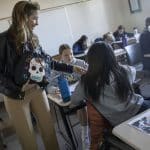Curriculum Spotlight: Honors Forensics
 “Seek!” roared members of the Honors Forensic class as their classroom door burst open, and an explosives detection K-9 named Grover charged through the door, dragging a U.S. Marshal behind. Within minutes, Grover was calmly sitting beside a small closed canister containing trace amounts of gunpowder at the rear of the classroom. The canister had been nested inside layers of tin cans like a Russian doll and hidden behind cardboard boxes and biology lab supplies.
“Seek!” roared members of the Honors Forensic class as their classroom door burst open, and an explosives detection K-9 named Grover charged through the door, dragging a U.S. Marshal behind. Within minutes, Grover was calmly sitting beside a small closed canister containing trace amounts of gunpowder at the rear of the classroom. The canister had been nested inside layers of tin cans like a Russian doll and hidden behind cardboard boxes and biology lab supplies.
During U.S. Marshal William Uhler and Grover’s dynamic visit to the class, forensic students took several turns leading Grover back into the classroom to find the same canister in various hidden locations. They learned that Grover can detect 19,000 distinct combinations of explosives, including ammunition and firearms. They learned some of the scientific principles behind Grover’s skills and that the U.S. Marshals Service trained Grover using the food reward methodology. They also learned that Grover must work daily with his handler to maintain this expertise.
As Marshal Uhler spoke to the class, he may not have known that he was reinforcing much of the knowledge these grade 12 forensics students have already learned through the physics, biology, and chemistry classes they have taken during their journey through the Upper School Science Department at Oak Knoll.
As Oak Knoll Science and Forensics Teacher Suzanne Monkemeier explained, “When we have guests like this speak to students, you never know how many topics they will touch upon that review what students have already learned or perhaps give them a preview of what’s around the corner.”
The Science Department added the semester-long Honors Forensics elective this year to complement the overall Science curriculum perfectly. It will be followed in the second semester by Anatomy and Physiology.
“I try to make the class as hands-on as possible to show that what the students learn in their science classes corresponds to real-life applications and careers,” said Monkemeier. “The definition of forensics is any time you use science to solve a problem. So you’ve got forensics for other fields as well. In this class, we take a narrower view of forensics and examine the use of science in solving crime and law enforcement.”
Students apply what they’ve learned in physics, chemistry, environmental science, or biology to principles in law enforcement. For example, they have used their knowledge of mitochondrial DNA versus nuclear DNA to understand the difference between class and identifying evidence. They have reviewed their understanding of Snell’s law and refraction to discuss how investigators can analyze glass fragments for evidence. They have also applied other scientific principles to discuss trace evidence, such as hair and fiber analysis.
Following the Christmas Break, they will apply much of what they’ve learned about forensics to analyze an entire crime scene fabricated by Oak Knoll’s security team — former law enforcement officers and actual crime scene investigators themselves.
Honors Forensics is an apt class to demonstrate the science curriculum’s overall goals — enabling students to develop a deep understanding of the natural world through empirical inquiry. In all science classes and throughout the Upper School years, students collect and interpret data in order to develop and confirm scientific theories that explain the natural world.






